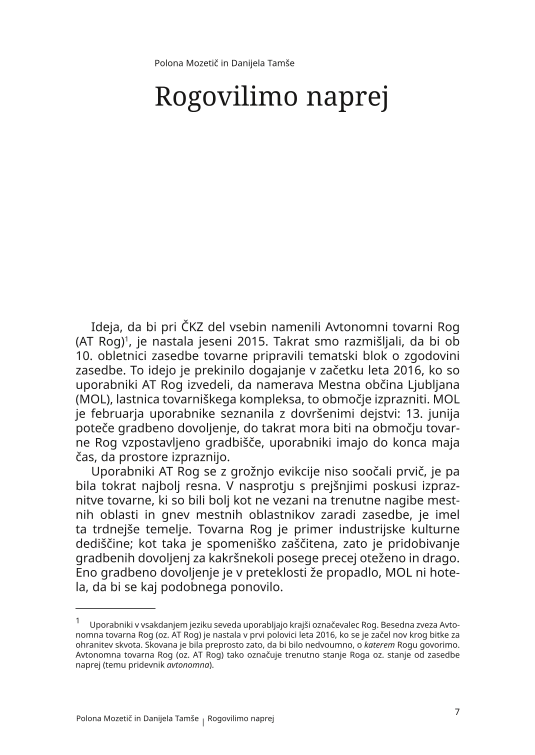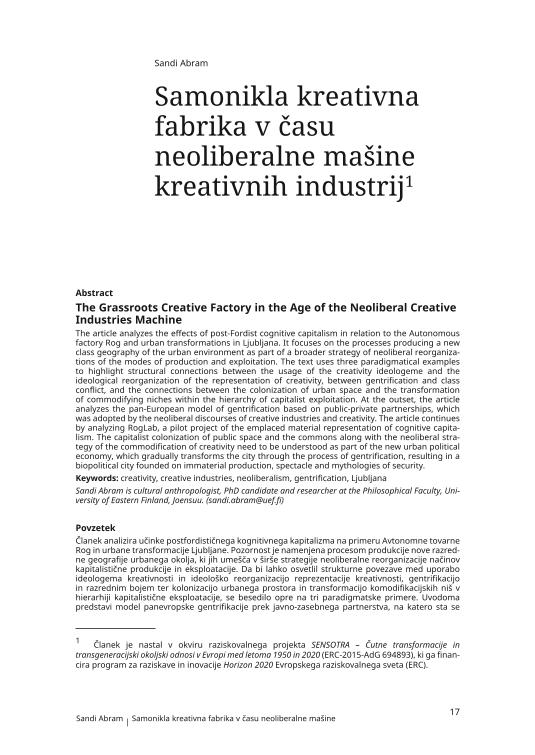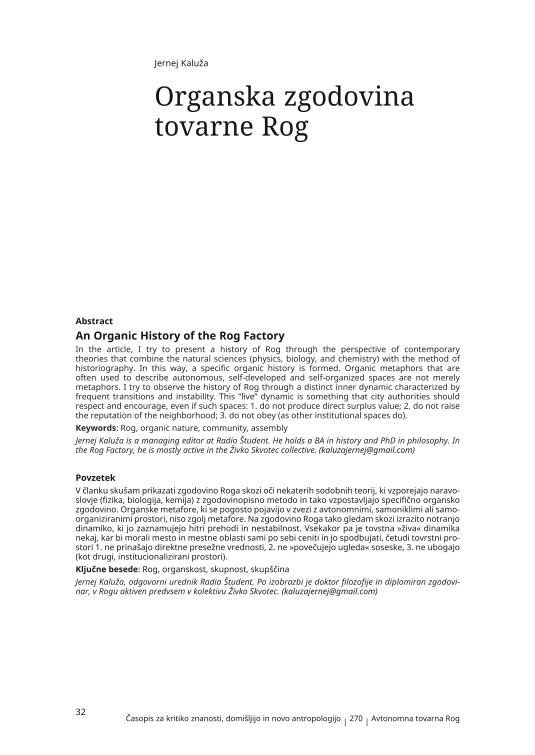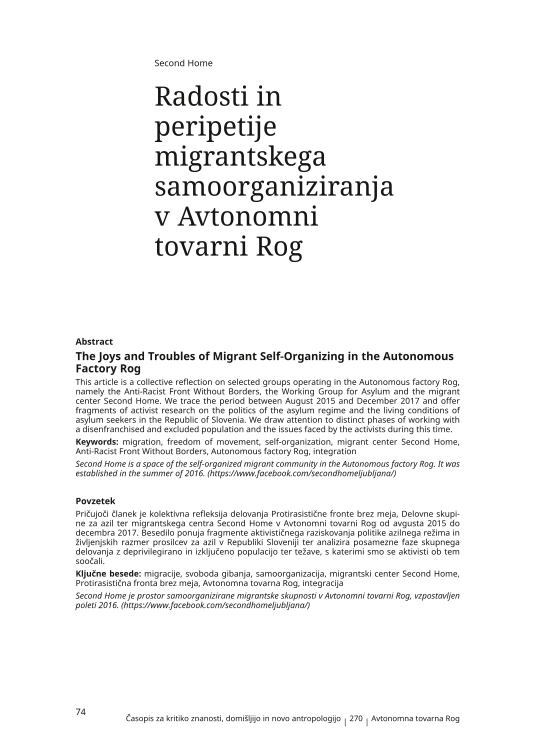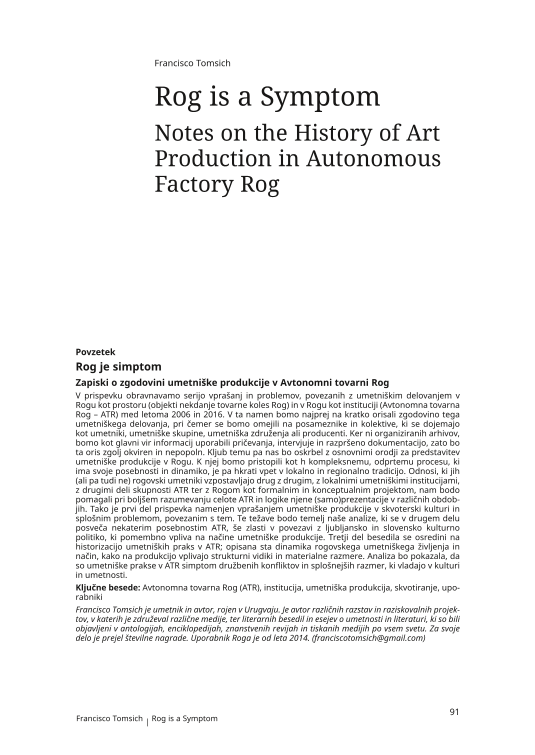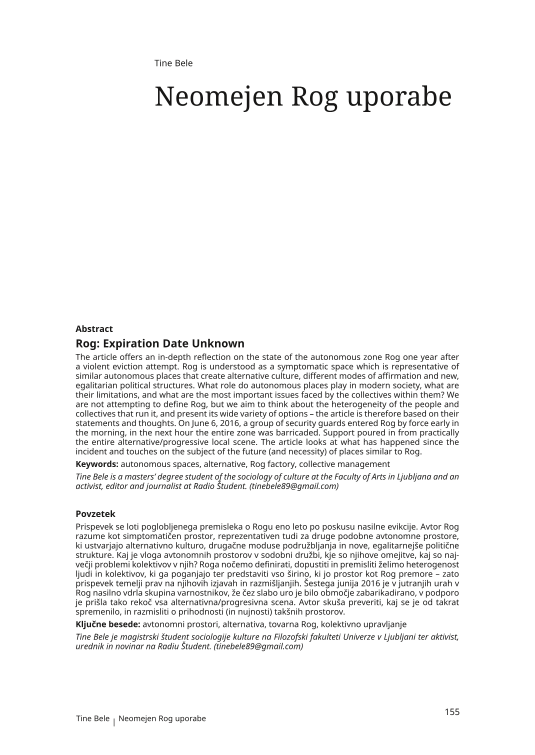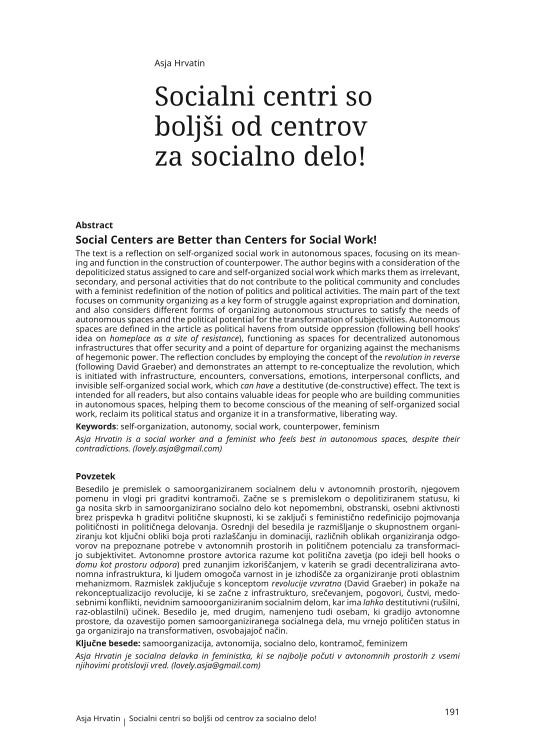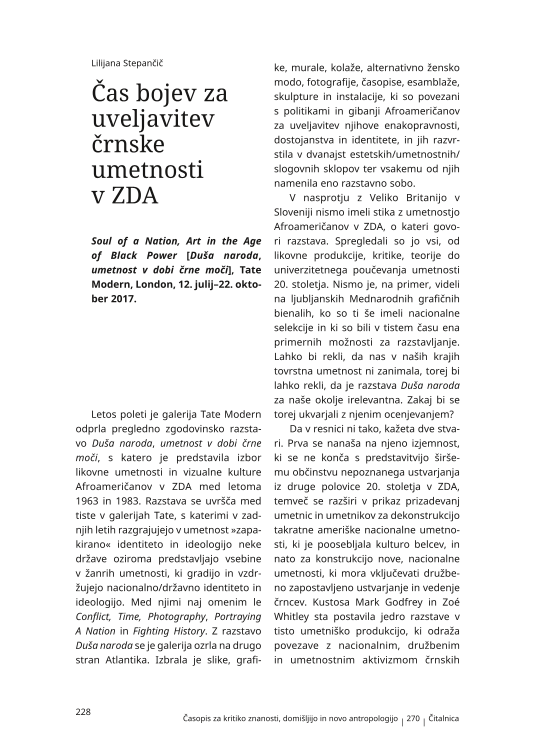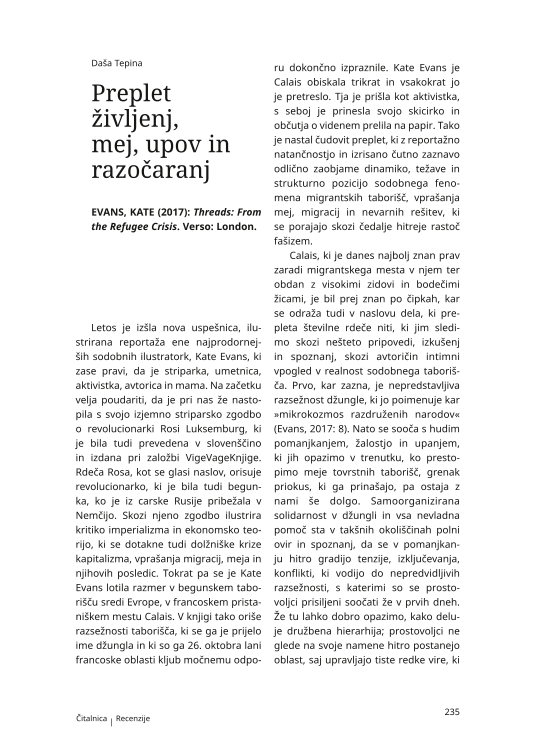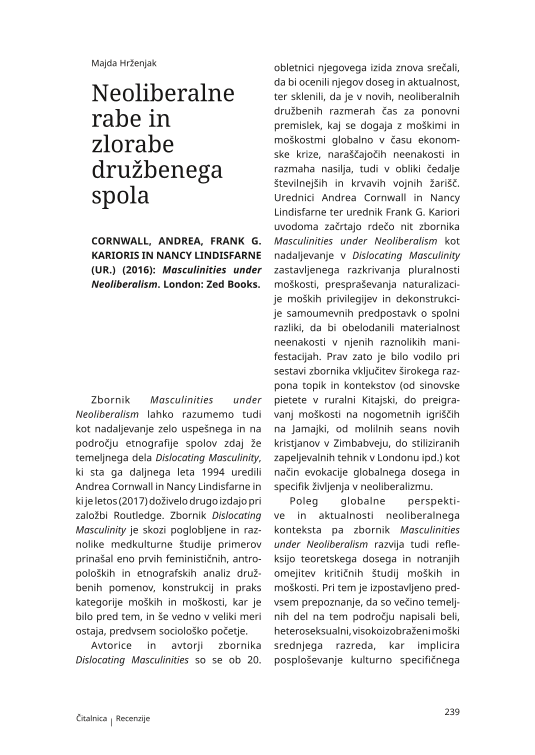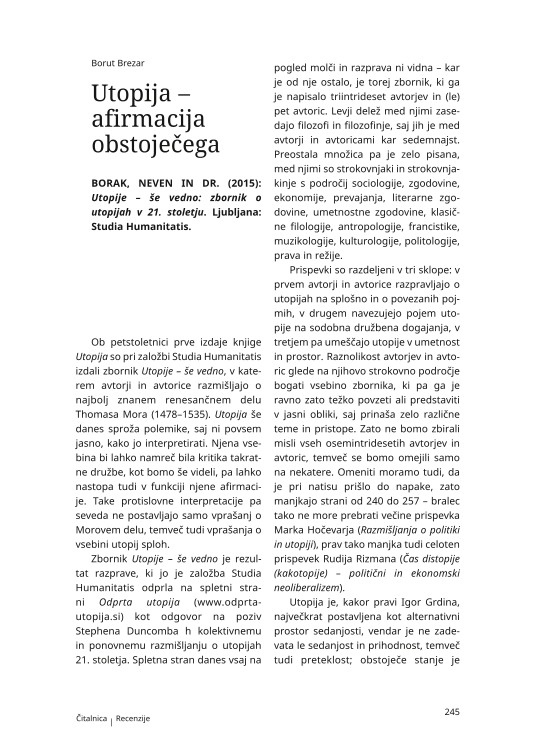Ideja, da bi pri ČKZ del vsebin namenili Avtonomni tovarni Rog (AT Rog)1, je nastala jeseni 2015. Takrat smo razmišljali, da bi ob 10. obletnici zasedbe tovarne pripravili tematski blok o zgodovini zasedbe. To idejo je prekinilo dogajanje v začetku leta 2016, ko so uporabniki AT Rog izvedeli, da namerava Mestna občina Ljubljana (MOL), lastnica tovarniškega kompleksa, to območje izprazniti. MOL je februarja uporabnike seznanila z dovršenimi dejstvi: 13. junija poteče gradbeno dovoljenje, do takrat mora biti na območju tovarne Rog vzpostavljeno gradbišče, uporabniki imajo do konca maja čas, da prostore izpraznijo.
Uporabniki AT Rog se z grožnjo evikcije niso soočali prvič, je pa bila tokrat najbolj resna. V nasprotju s prejšnjimi poskusi izpraznitve tovarne, ki so bili bolj kot ne vezani na trenutne nagibe mestnih oblasti in gnev mestnih oblastnikov zaradi zasedbe, je imel ta trdnejše temelje. Tovarna Rog je primer industrijske kulturne dediščine; kot taka je spomeniško zaščitena, zato je pridobivanje gradbenih dovoljenj za kakršnekoli posege precej oteženo in drago. Eno gradbeno dovoljenje je v preteklosti že propadlo, MOL ni hotela, da bi se kaj podobnega ponovilo.
The Grassroots Creative Factory in the Age of the Neoliberal Creative Industries Machine
(
The article analyzes the effects of post-Fordist cognitive capitalism in relation to the Autonomous factory Rog and urban transformations in Ljubljana. It focuses on the processes producing a new class geography of the urban environment as part of a broader strategy of neoliberal reorganizations of the modes of production and exploitation. The text uses three paradigmatical examples to highlight structural connections between the usage of the creativity ideologeme and the ideological reorganization of the representation of creativity, between gentrification and class conflict, and the connections between the colonization of urban space and the transformation of commodifying niches within the hierarchy of capitalist exploitation. At the outset, the article analyzes the pan-European model of gentrification based on public-private partnerships, which was adopted by the neoliberal discourses of creative industries and creativity. The article continues by analyzing RogLab, a pilot project of the emplaced material representation of cognitive capitalism. The capitalist colonization of public space and the commons along with the neoliberal strategy of the commodification of creativity need to be understood as part of the new urban political economy, which gradually transforms the city through the process of gentrification, resulting in a biopolitical city founded on immaterial production, spectacle and mythologies of security.
In the article, I try to present a history of Rog through the perspective of contemporary theories that combine the natural sciences (physics, biology, and chemistry) with the method of historiography. In this way, a specific organic history is formed. Organic metaphors that are often used to describe autonomous, self-developed and self-organized spaces are not merely metaphors. I try to observe the history of Rog through a distinct inner dynamic characterized by frequent transitions and instability. This “live” dynamic is something that city authorities should respect and encourage, even if such spaces: 1. do not produce direct surplus value; 2. do not raise the reputation of the neighborhood; 3. do not obey (as other institutional spaces do).
The article evaluates the Center of Contemporary Arts Rog project and relates the course of events following the competition to the question of architectural autonomy and the institution of the public architectural competition. The basis of the argumetation is Adorno‘s concept of architecture as a useful art. The question of aesthetic reflection, which Adorno opens up along with the question of space, is developed further with Rancière‘s concept of the distribution of the sensible. The understanding of architecture as a form of sensible experience is interpreted as the basis for a potential redefinition of the conditions of architectural competitions. Consequently, this calls for a rethinking of the activities within the architectural discipline.
This article is a collective reflection on selected groups operating in the Autonomous factory Rog, namely the Anti-Racist Front Without Borders, the Working Group for Asylum and the migrant center Second Home. We trace the period between August 2015 and December 2017 and offer fragments of activist research on the politics of the asylum regime and the living conditions of asylum seekers in the Republic of Slovenia. We draw attention to distinct phases of working with a disenfranchised and excluded population and the issues faced by the activists during this time.
This essay will address a series of issues and problems related to art practices based in and settled in Rog as a space (the facilities of the former Rog bicycle factory) as well as related to Rog as an institution (Autonomous factory Rog – ATR) between 2006 and 2016. In order to do so, it will be necessary to sketch a short history of this art production, as restricted to individual and collectives that consider themselves as artists, art groups, association of artists and/or art producers. Due to the lack of organized archives, this narrative will be making use of testimonies, interviews and dispersed documents as main sources and as such must be considered provisional and incomplete. It will, however, provide us some preliminary tools for studying art production in Rog in its own context, addressing it as a complex open process that has its own specificities and dynamics and it is at the same time inscribed in local and regional traditions. The relationship (or absence thereof) that artists working in Rog establish among themselves as a group, with local art institutions, with the rest of the community of ATR’s users and with ATR as a project in formal and conceptual terms, will help us toward a better understanding of ATR as a whole and the logic of its (self-)representation in different moments of its history. The first part of this essay deals with the issue of art production in squat culture and the general problems it usually poses. These problems will lie at the base of the rest of the analysis, which looks in its second part at some specificities of ATR in the context of Ljubljana and Slovenian culture that in a large way affect the way art is produced there. The historization of art practices in the context of ATR is the main focus of the third part of this text. I describe there some dynamics of Rog’s artistic life in this framework, and how structural aspects and material conditions of production determine and influence the kind of art that is and has been made in Rog. The sum of all these aspects will speak about how art practices of ATR function as very symptoms of more general cultural diseases, artistic conditions and social conflicts.
Modri kot (Blue Corner – MK) is a fluid community in and around the MK space. It is also a self-creating scene outside and around the space and other collectives in the Autonomous factory Rog. In the text, some of MK‘s users try to capture its elusive appearance, form and content. The text itself is a reflection of MK‘s slippery character, experimentally combining various genres ranging from drama to autoetnography and low theory. It is mainly composed out of edited notes from MK meetings, reflections and memories of its users, obscure phantasies, explicit needs, event invitations, and internal emails.
Feminism should be inherent to all forms of autonomous organizing. The notion that feminism is not a women’s issue, but rather a method of addressing patriarchal practices and the analysis of structural relations is being discussed in this article through concrete examples of contradictions forming the daily struggle for the reclamation of (autonomous) space. The article includes an analysis of the constitution of the political subject and the hierarchical differentiation between the personal and political, as well as thoughts on invisible reproductive emotional and care work, violence in the community, and ways of addressing and examining general assemblies as political spaces containing the dynamics of domination. We reflect on issues of informal hierarchies, exclusions based on the hierarchisation of discourses (stuttering versus avant-garde), and distinctions between the emotional, rational, personal, and political resulting in personal relationships, safety, well-being, solidarity and friendship being seen as obstacles hindering political work. We share our experiences from assemblies, where feminism has to fight for recognition as a relevant political topic. Furthermore, the text shows how patriarchal definitions of political organizing and violence infiltrate autonomous spaces and how attempts by queer-feminists to address these issues are faced with resistance from the community. The criticism of the division between political work and the reproduction of everyday life is ever-present in the article, since we advocate for the idea that autonomy cannot be constructed without feminist practices. The article, which breaks completely with the form and language used in this abstract (and is, in that sense, experimental) concludes with the analysis of the empowering practices of autonomous queer-feminism in Rog.
The article offers an in-depth reflection on the state of the autonomous zone Rog one year after a violent eviction attempt. Rog is understood as a symptomatic space which is representative of similar autonomous places that create alternative culture, different modes of affirmation and new, egalitarian political structures. What role do autonomous places play in modern society, what are their limitations, and what are the most important issues faced by the collectives within them? We are not attempting to define Rog, but we aim to think about the heterogeneity of the people and collectives that run it, and present its wide variety of options – the article is therefore based on their statements and thoughts. On June 6, 2016, a group of security guards entered Rog by force early in the morning, in the next hour the entire zone was barricaded. Support poured in from practically the entire alternative/progressive local scene. The article looks at what has happened since the incident and touches on the subject of the future (and necessity) of places similar to Rog.
The article provides an analysis of graffiti in the Autonomous factory Rog on the basis of a concise ethnographic analysis of archival resources, testimonies, and field research. Graffiti are interpreted as an important tool that squatters use for the conceptualization of space, and also as a visual symbol of this process. The article provides an extensive ethnographic description of the development of the phenomenon throughout the entirety of the autonomous factory‘s existence. The material is interpreted through the concept of the social production of space and spatiality. By combining cultural anthropological analysis and humanistic cultural geography, the article attempts to explain the social production of spatial practices and perceived space.
The text is a reflection on self-organized social work in autonomous spaces, focusing on its meaning and function in the construction of counterpower. The author begins with a consideration of the depoliticized status assigned to care and self-organized social work which marks them as irrelevant, secondary, and personal activities that do not contribute to the political community and concludes with a feminist redefinition of the notion of politics and political activities. The main part of the text focuses on community organizing as a key form of struggle against expropriation and domination, and also considers different forms of organizing autonomous structures to satisfy the needs of autonomous spaces and the political potential for the transformation of subjectivities. Autonomous spaces are defined in the article as political havens from outside oppression (following bell hooks’ idea on homeplace as a site of resistance), functioning as spaces for decentralized autonomous infrastructures that offer security and a point of departure for organizing against the mechanisms of hegemonic power. The reflection concludes by employing the concept of the revolution in reverse (following David Graeber) and demonstrates an attempt to re-conceptualize the revolution, which is initiated with infrastructure, encounters, conversations, emotions, interpersonal conflicts, and invisible self-organized social work, which can have a destitutive (de-constructive) effect. The text is intended for all readers, but also contains valuable ideas for people who are building communities in autonomous spaces, helping them to become conscious of the meaning of self-organized social work, reclaim its political status and organize it in a transformative, liberating way.
Up until 2008, the renovation of the empty Rog factory in Ljubljana followed two paths. The first path involved interventions made by civil society, which changed the former factory into a site for cultural and social events. Rog was supposed to be the location of workshops, a ballet school, art academies, a museum of technology, a Kunsthalle, art studios, a hospital, a covered marketplace and a home for the Strojans, a Roma family. Around the year 2000, the Association designated Rog as a centre for contemporary art and visual culture. Up until 2000, Rog hosted three major exhibitions: the 16th and 17th Biennials of Industrial Design and Break 21. The second path taken in the renovation of Rog concerns the procedures and activities carried out by the municipality of Ljubljana. In 2002, it leased the factory from its owners, but eventually became the owner itself in 2014. Other activities of the municipality with regard to Rog included the organisation of an international colloquium on urban rejuvenation (1995) and the definition of new conditions for the spatial organisation of Rog (1998), in which the municipality determined that Rog was to become a city quarter with spaces for apartments and various enterprises connected to the creative industries. The municipality subsequently developed an architectural plan for Rog (the project was carried out in collaboration with the International Centre for Architecture, Design, and the Urban Arts in 2007), choosing the architectural solution provided by Marjan Bežan and the architectural team MX – SI (2008). For the powers that be in Ljubljana, the renovation and reorganisation of Rog is more a lucrative object of political marketing targeted at progressive individuals than it is an opportunity to create permanent conditions in which progressive ideas could operate.
KLASIĆ, HRVOJE (2015): Jugoslavija in svet leta 1968. Ljubljana: Beletrina.
Hannah Arendt je na začetku poletja 1968 svojemu prijatelju, filozofu Karlu Jaspersu, pisala, da se bodo otroci v prihodnjem stoletju o omenjenem letu učili tako, kakor se je njena in Jaspersova generacija učila o letu 1848. Nekateri otroci (v) prihodnosti bodo nekje (iz)vedeli, kaj so tistega leta počeli njihovi stari starši, kot tudi, da je imel hrvaški zgodovinar Hrvoje Klasić v prvem desetletju »njihovega« stoletja nemalo težav pri izbiri kakovostne literature za sestavo monografije o jugoslovanskem letu 1968 in njenem sočasnem pogledu na svet, zaradi česar je moral svoj raziskovalni interes preusmeriti predvsem na počasi odpirajoča se in do tedaj namenoma zaprašena arhivska gradiva in sekundarne vire. Iz gradiva beograjskega Arhiva Jugoslavije in zagrebškega Hrvaškega državnega arhiva je sestavljal podobo »oseminšestdesetega«, ki so ga zapustile jugoslovanske družbenopolitične organizacije (Zveza mladine, Zveza študentov, Socialistična zveza, Zveza borcev), gradivo iz londonskega, praškega in washingtonskega arhiva pa mu je osvetlilo raznolike mednarodne vidike v odnosu do »socialističnega eksperimenta«, Titove Jugoslavije.
Soul of a Nation, Art in the Age of Black Power [Duša naroda, umetnost v dobi črne moči], Tate Modern, London, 12. julij–22. oktober 2017.
Letos poleti je galerija Tate Modern odprla pregledno zgodovinsko razstavo Duša naroda, umetnost v dobi črne moči, s katero je predstavila izbor likovne umetnosti in vizualne kulture Afroameričanov v ZDA med letoma 1963 in 1983. Razstava se uvršča med tiste v galerijah Tate, s katerimi v zadnjih letih razgrajujejo v umetnost »zapakirano« identiteto in ideologijo neke države oziroma predstavljajo vsebine v žanrih umetnosti, ki gradijo in vzdržujejo nacionalno/državno identiteto in ideologijo. Med njimi naj omenim le Conflict, Time, Photography, Portraying A Nation in Fighting History. Z razstavo Duša naroda se je galerija ozrla na drugo stran Atlantika. Izbrala je slike, grafike, murale, kolaže, alternativno žensko modo, fotografije, časopise, esamblaže, skulpture in instalacije, ki so povezani s politikami in gibanji Afroameričanov za uveljavitev njihove enakopravnosti, dostojanstva in identitete, in jih razvrstila v dvanajst estetskih/umetnostnih/slogovnih sklopov ter vsakemu od njih namenila eno razstavno sobo.
EVANS, KATE (2017): Threads: From the Refugee Crisis. Verso: London.
Letos je izšla nova uspešnica, ilustrirana reportaža ene najprodornejših sodobnih ilustratork, Kate Evans, ki zase pravi, da je striparka, umetnica, aktivistka, avtorica in mama. Na začetku velja poudariti, da je pri nas že nastopila s svojo izjemno striparsko zgodbo o revolucionarki Rosi Luksemburg, ki je bila tudi prevedena v slovenščino in izdana pri založbi VigeVageKnjige. Rdeča Rosa, kot se glasi naslov, orisuje revolucionarko, ki je bila tudi begunka, ko je iz carske Rusije pribežala v Nemčijo. Skozi njeno zgodbo ilustrira kritiko imperializma in ekonomsko teorijo, ki se dotakne tudi dolžniške krize kapitalizma, vprašanja migracij, meja in njihovih posledic. Tokrat pa se je Kate Evans lotila razmer v begunskem taborišču sredi Evrope, v francoskem pristaniškem mestu Calais. V knjigi tako oriše razsežnosti taborišča, ki se ga je prijelo ime džungla in ki so ga 26. oktobra lani francoske oblasti kljub močnemu odporu dokončno izpraznile. Kate Evans je Calais obiskala trikrat in vsakokrat jo je pretreslo. Tja je prišla kot aktivistka, s seboj je prinesla svojo skicirko in občutja o videnem prelila na papir. Tako je nastal čudovit preplet, ki z reportažno natančnostjo in izrisano čutno zaznavo odlično zaobjame dinamiko, težave in strukturno pozicijo sodobnega fenomena migrantskih taborišč, vprašanja mej, migracij in nevarnih rešitev, ki se porajajo skozi čedalje hitreje rastoč fašizem.
CORNWALL, ANDREA, FRANK G. KARIORIS IN NANCY LINDISFARNE (UR.) (2016): Masculinities under Neoliberalism. London: Zed Books.
Zbornik Masculinities under Neoliberalism lahko razumemo tudi kot nadaljevanje zelo uspešnega in na področju etnografije spolov zdaj že temeljnega dela Dislocating Masculinity, ki sta ga daljnega leta 1994 uredili Andrea Cornwall in Nancy Lindisfarne in ki je letos (2017) doživelo drugo izdajo pri založbi Routledge. Zbornik Dislocating Masculinity je skozi poglobljene in raznolike medkulturne študije primerov prinašal eno prvih feminističnih, antropoloških in etnografskih analiz družbenih pomenov, konstrukcij in praks kategorije moških in moškosti, kar je bilo pred tem, in še vedno v veliki meri ostaja, predvsem sociološko početje.
BORAK, NEVEN IN DR. (2015): Utopije – še vedno: zbornik o utopijah v 21. stoletju. Ljubljana: Studia Humanitatis.
Ob petstoletnici prve izdaje knjige Utopija so pri založbi Studia Humanitatis izdali zbornik Utopije – še vedno, v katerem avtorji in avtorice razmišljajo o najbolj znanem renesančnem delu Thomasa Mora (1478–1535). Utopija še danes sproža polemike, saj ni povsem jasno, kako jo interpretirati. Njena vsebina bi lahko namreč bila kritika takratne družbe, kot bomo še videli, pa lahko nastopa tudi v funkciji njene afirmacije. Take protislovne interpretacije pa seveda ne postavljajo samo vprašanj o Morovem delu, temveč tudi vprašanja o vsebini utopij sploh.




